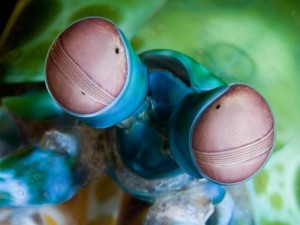The Mantis Shrimp
The mantis shrimp diverged evolutionarily from the crustacean mainline about 400 years ago and have since developed unique characteristics. Unlike most other crustaceans, they actively hunt prey and kill it with a crushing blow which has been theorized to be strong enough to create bubbles containing gas at temperatures upwards of 2000 Kelvin. This quality, however, is nowhere near as stunning as the mantis shrimp’s most incredible attribute: their eyes. In April 2001, the most comprehensive paper to date describing the mantis shrimp’s visual system was published by Justin Marshall and Thomas Cronin in The Biological Bulletin. In their paper, the authors described the unusual characteristics of the mantis shrimp visual system and hypothesized the applications of this system in the development of machine vision.

Mantis Shrimp Eye via New Scientist
The first moderately unique quality of the mantis shrimp eye is a property which arises simply from the anatomy itself. Each eye is broken up into three distinct areas: two hemispherical regions on either side of a central “midband” area. Interestingly, each ommatidium (photoreceptor) in the hemispherical regions has a corresponding ommatidium in the opposing hemisphere with which it shares a visual field. This characteristic allows for stereoscopic visual perception within each eye. In other words, each eye of the mantis shrimp has the internal ability to produce depth perception and create a three-dimensional representation of the world without input from the other eye. While the eyes of humans have to move in synchrony in order to create depth perception, the eyes of the mantis shrimp can move freely from one another and still possess the ability to model the surrounding world in three dimensions.
The next interesting ability of the mantis shrimp eye that the authors discussed was its ability to qualitatively detect polarized light. Most objects reflect light of a specific wavelength which gives rise to color vision. In a similar fashion, most objects also reflect light with a certain polarization that is characteristic of the material itself and mantis shrimp have the unique ability to detect and distinguish different planes of polarization, allowing them to identify materials at a distance.
On a final but similar note, the authors also suggest that the mantis shrimp eye also might possess the extremely unique ability to make sense of circularly polarized light. Circularly polarized light is an emergent property of the reflected light of some metals and membranes, and the authors seem to believe that the shrimp’s R8 receptor may act as a quarter-wavelength retarder which would allow the animal to convert circularly polarized light into linearly polarized light which they could then sense using their previously described polarized light receptor system.
The most important conclusion the authors suggest can be drawn from this paper is the parallel processing systems used to detect all of these different properties of light. Since most of the shrimp’s ommatidia or photoreceptors are specific for detecting a single light property, little higher level processing of the information is needed. This layout, they say, is a potent model for the creation of machine vision systems as little higher level processing is needed for extremely precise color vision. The authors think that this sort of thinking – drawing ideas for mechanical systems through the design of biological ones – will be increasingly important in the future. That aside, the mantis shrimp is an incredible animal and the inner workings of the eye are still very much a mystery and will require much more research to fully understand.
Parallel Processing and Image Analysis in the Eyes of Mantis Shrimps – The Biological Bulletin
The Art of Thriving -New Scientist
January 20, 2012
It is interesting to know how the mantis shrimp specialized study can help us enjoy a good vision.
I’m glad there are people working in this field